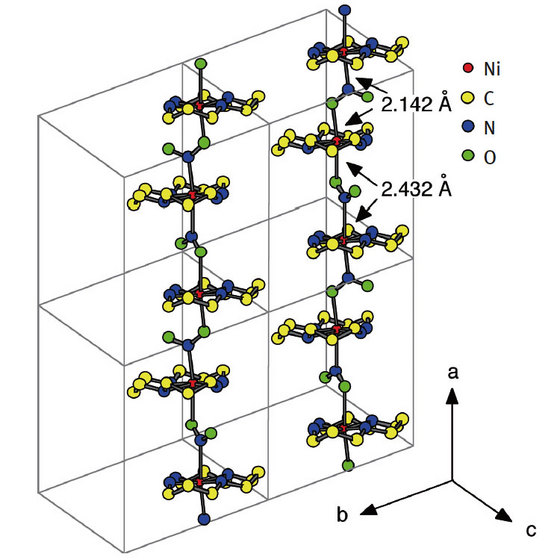Jul. 5, 2006 Research Highlight Physics / Astronomy
Cool molecule reveals its true nature
Elusive quantum state observed in designer molecule
 Figure 1: The molecular structure of NTENP, Ni(C9H24N4)NO2(ClO4).
Figure 1: The molecular structure of NTENP, Ni(C9H24N4)NO2(ClO4).
When things get small, materials change their physical properties significantly. In particular at lower dimensions, the behavior of electrons can be very different. Imagine driving on a highway without the possibility of overtaking other cars—if some cars are slower than others, a traffic jam occurs. Indeed, the most efficient organization in such an environment is if all cars synchronize and drive at exactly the same speed. The same occurs to electrons in one-dimensional systems at low temperatures; they synchronize themselves and rearrange into complex quantum states.
One such quantum state for onedimensional systems was described by S. Tomonaga and J. M. Luttinger, and is now known as the Tomonaga-Luttinger liquid (TLL). Previously, this quantum state has been observed mainly in carbon nanotubes and quantum wires.
However, when a magnetic field is involved, the physics become more complex. For antiferromagnets with an energy gap—magnetic systems where the magnetic field is alternating between ‘up’ and ‘down’ states—the TLL competes with other quantum states. Only at higher magnetic fields is the TLL expected to form. “To date, however, all experimental evidence in these gapped antiferromagnets has been either controversial or circumstantial,” says Hiroyuki Tsujii from RIKEN’s Discovery Research Institute in Wako. Together with researchers from Osaka University, the University of Florida and the Advanced Science Research Center in Tokai, the RIKEN group went on the hunt for this elusive quantum state.
The key to a conclusive observation of the TLL lies in the material itself, as the symmetry of the molecule has to be precise in order to obtain clear experimental evidence. An attractive candidate is NTENP (Fig. 1).
However, synthesis and characterization of NTENP was not the last hurdle in the search for TLL. The right equipment needed to be built first. In the experiments, tiny changes in the specific heat of the molecule have to be measured at high magnetic fields and low temperatures. “Crucial has been the development of the low-temperature calorimeters, which are capable of reaching 34 mK in magnetic fields up to 20 T,” explains Tsujii.
Using this new equipment, the measurements performed at the National High Magnetic Field Laboratory in Florida, USA and at Osaka University, show striking evidence for the TLL state1. Based on these promising results, the next step is to expand our knowledge of the TLL state and as Tsujii says, “To measure the specific heat at higher magnetic fields to extend the phase diagram as well as to check how the TLL behavior persists.”
References
- 1. Hagiwara, M., Tsujii, H., Rotund, C.R., Andraka, B., Takano, Y. Tateiwa, N. et al. Tomonaga-Luttinger liquid in a quasione- dimensional S=1 antiferromagnet bserved by specific heat measurements. Phys. Rev. Lett. 96, 147203 (2006). doi: 10.1103/PhysRevLett.96.147203
